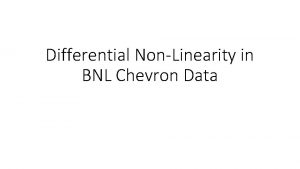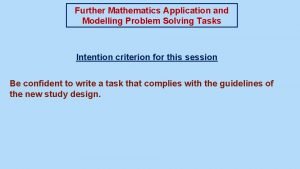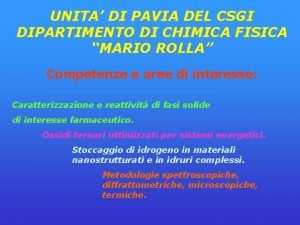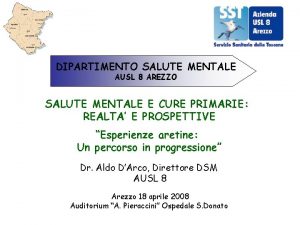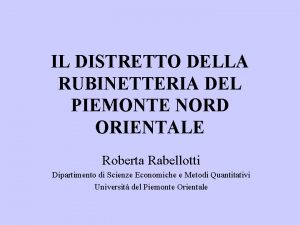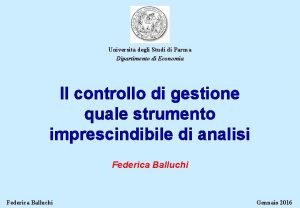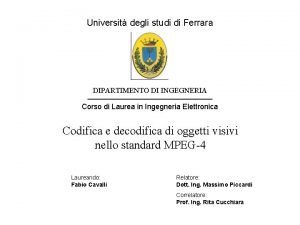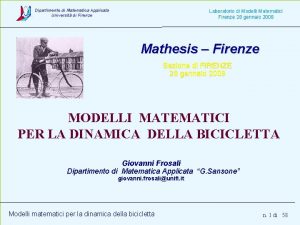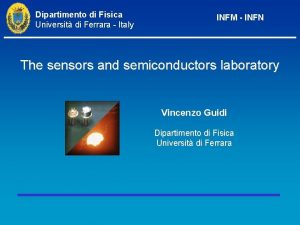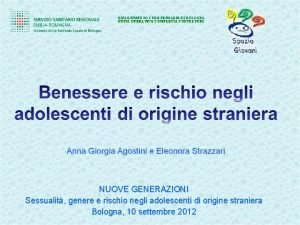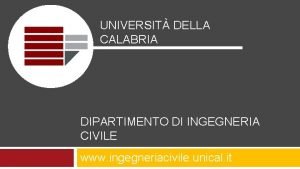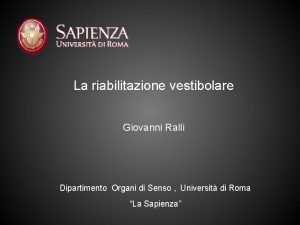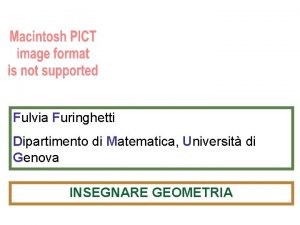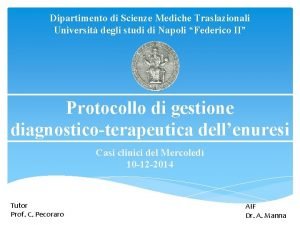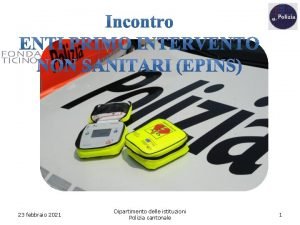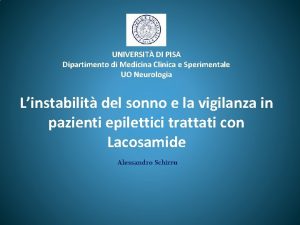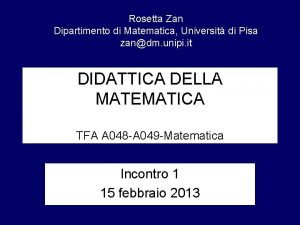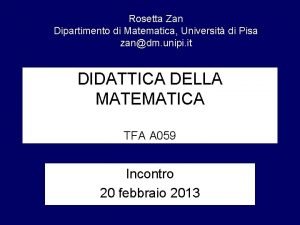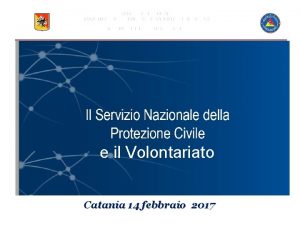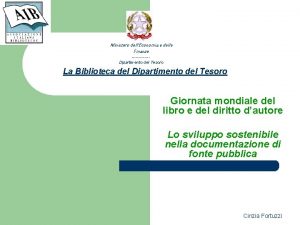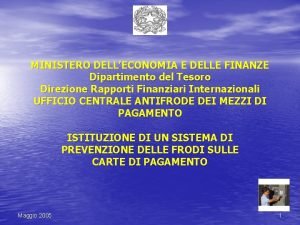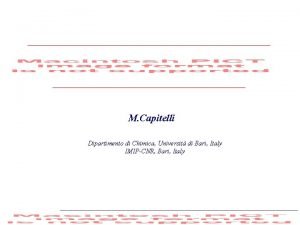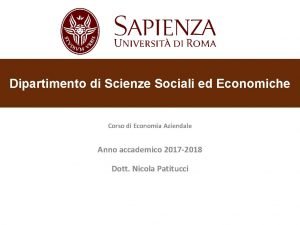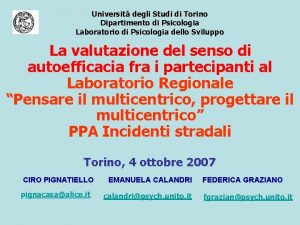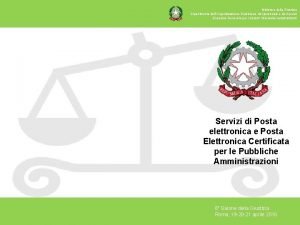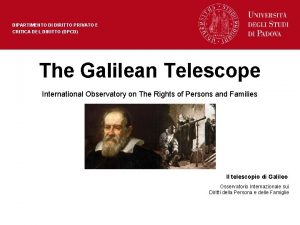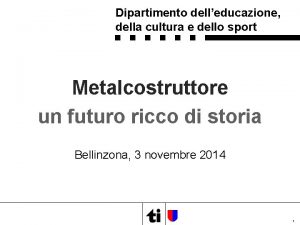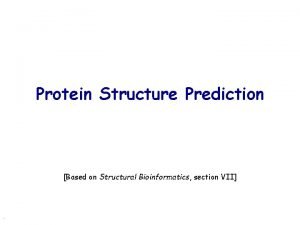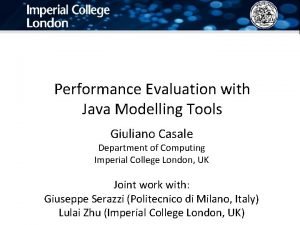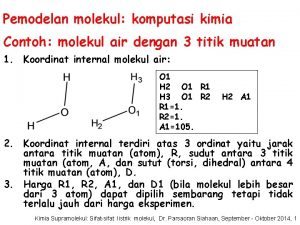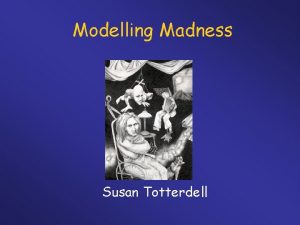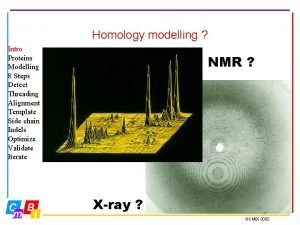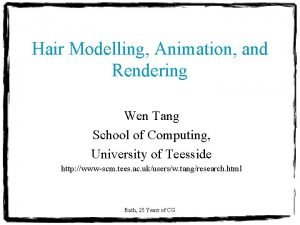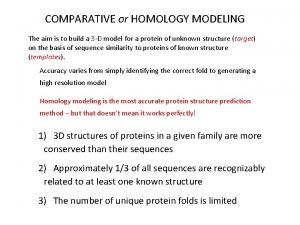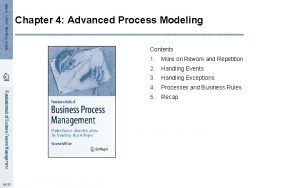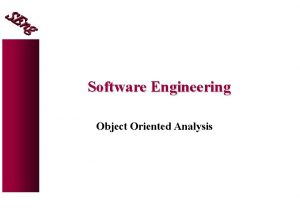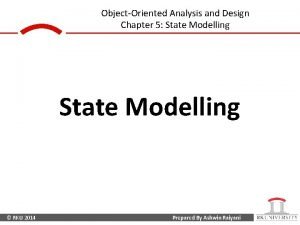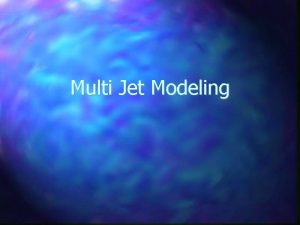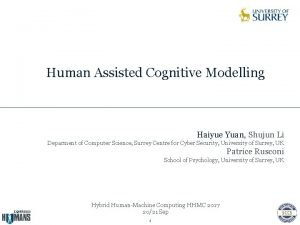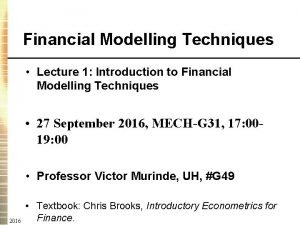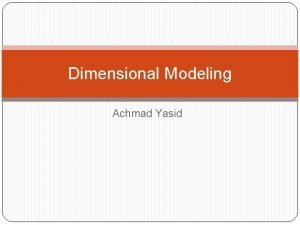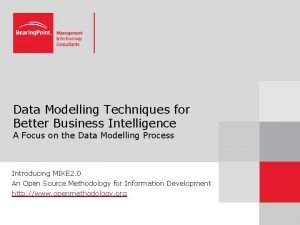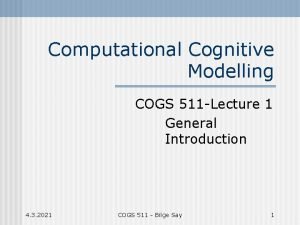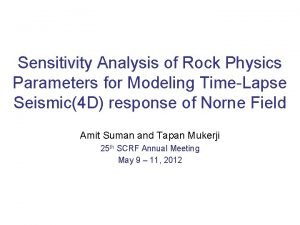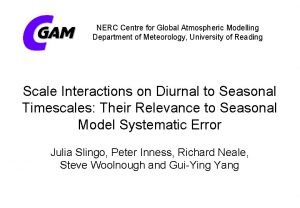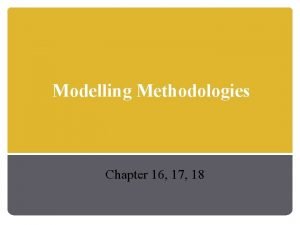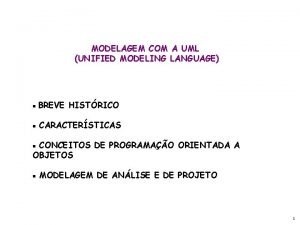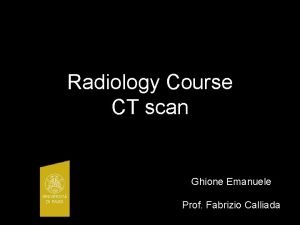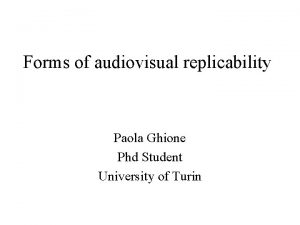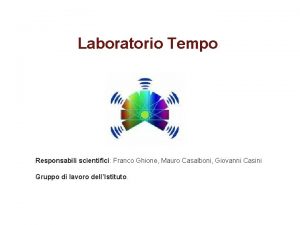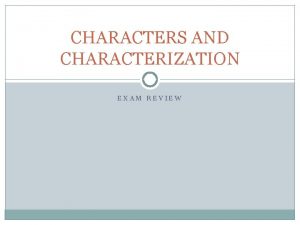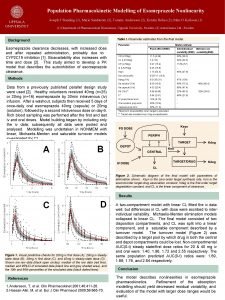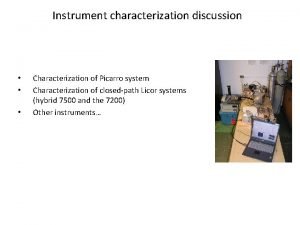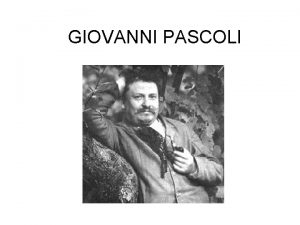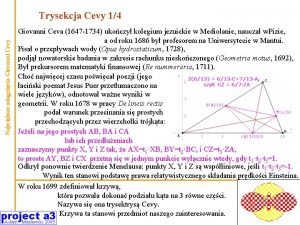Nonlinearity characterization and modelling Giovanni Ghione Dipartimento di
























































![Basics of Load Pull Example of Load Pull data Output Power [d. Bm] @ Basics of Load Pull Example of Load Pull data Output Power [d. Bm] @](https://slidetodoc.com/presentation_image_h2/fb6761bbd6f8d901c0ccfee67f2b5408/image-57.jpg)
























- Slides: 81

Nonlinearity characterization and modelling Giovanni Ghione Dipartimento di Elettronica Politecnico di Torino Microwave & RF electronics group NEWCOM WPR 3 Meeting – 6/9/04

Agenda n A glimpse on nonlinear models n Physics-based device-level models n Equivalent circuit & black-box device-level models n Vintage behavioral models: power series, Volterra, envelope n Advanced models: time-domain, frequency-domain, envelope n Characterization techniques (mainly loadpull…) n Aknowledgements NEWCOM WPR 3 Meeting – 6/9/04

Device models: from physical to behavioral NEWCOM WPR 3 Meeting – 6/9/04 From: D. Root et al. , IMS 2004 WME-4

Physics-based nonlinear modeling n Based on the solution of transport + Poisson equations on device volume n Mainly single-device, mixed-mode intensive n Often time-domain, Harmonic Balance LS simulation demonstrated but demanding (>10000 unknowns) order reduction techniques? n Potentially accurate, but NL operation can be a numerical killer (breakdown, direct junction conduction…) NEWCOM WPR 3 Meeting – 6/9/04

Example: LDMOS PA simulation From: Troyanovsky et al, SISPAD 1997 NEWCOM WPR 3 Meeting – 6/9/04

Circuit-oriented NL modelling n Equivalent circuit NL models: n Extensions of DC + small signal models with NL components n Ad hoc topologies for device classes: BJT, HBT, MESFETs, HEMTs, MOS, LDMOS… n Almost endless variety of topologies and component models from the shelf, many models proprietary n Empirical, semi-empirical, physics-based analytical varieties. n Pros: numerically efficient, accurate enough for a given technology after much effort and tweaking n Cons: not a general-purpose strategy, low-frequency dispersion (memory) effect modelling difficult NEWCOM WPR 3 Meeting – 6/9/04

NL equivalent circuit examples n. Bipolar: n. BJT: Ebers-Moll, Gummel-Poon n. HBT: Modified GP, MEXTRAM… n. FET: n. MOS: SPICE models, BSIM models… n. MESFET: Curtice, Statz, Materka, TOM… n. HEMT: Chalmers, COBRA… NEWCOM WPR 3 Meeting – 6/9/04

Example: the Curtice MESFET model NEWCOM WPR 3 Meeting – 6/9/04

Example: the HBT MEXTRAM model NEWCOM WPR 3 Meeting – 6/9/04

Black-box device-level modelling n Black-box models for circuit NL components: n Look-up-table, interpolatory (e. g. Root) n Static Neural Network based n Global black-box (“grey-box”) device-level (? ): n The Nonlinear Integral Model (University of Bologna) based on dynamic Volterra expansion + parasitic extraction n Potentially accurate, but computationally intensive NEWCOM WPR 3 Meeting – 6/9/04

Non-quasi static effects n Device level: low-frequency dispersion due to: n Trapping effects, surfaces, interfaces n Thermal effects n Amplifier level: n Bias effect (lowpass behavior of bias tees) n Thermal effect n Impact on device modelling pulsed DC and SS measurements NEWCOM WPR 3 Meeting – 6/9/04

Pulsed IV characteristics n Investigation of the device behaviour outside the SOA region n Pulsed measurement for exploiting thermal and traps effects n Different QP with the same dissipated power n Point out flaws of the fabbrication processes (e. g. passivation faults, uncompensated deep traps) n Allow the identification of the dispersive model contributions NEWCOM WPR 3 Meeting – 6/9/04

Pulsed IV: FET example NEWCOM WPR 3 Meeting – 6/9/04

System-level (behavioral) NL models n Classical & textbook results: n Power and Volterra series (wideband) models, frequency or time-domain n Envelope (narrowband) static models descriptive function n A sampler of more innovative techniques: n Dynamic time-domain models n Dynamic neural network models n Dynamic f-domain models scattering functions n Advanced envelope models NEWCOM WPR 3 Meeting – 6/9/04

Recalling a few basics n. PA single-tone test n. PA two-tone test n. PA modulated signal test n. Intermodulation products, ACPR… NEWCOM WPR 3 Meeting – 6/9/04

Single-tone PA test PA 3 rd harmonics output intercept 1 d. B compression point Output saturation power NEWCOM WPR 3 Meeting – 6/9/04

Two-tone PA test n Rationale: two-tone operation “simulates” narrowband operation on a continuous band f 1 - f 2 PA NEWCOM WPR 3 Meeting – 6/9/04

Two-tone Pin-Pout NEWCOM WPR 3 Meeting – 6/9/04

Modulated signal test & ACPR NEWCOM WPR 3 Meeting – 6/9/04

Class A AB C two-tone test NEWCOM WPR 3 Meeting – 6/9/04 Fager et al, IEEE JOURNAL OF SOLID-STATE CIRCUITS, VOL. 39, NO. 1, JANUARY 2004, p. 24

Power series (PS) model n Strictly speaking an IO model for a memoryless NL system, often cascaded with a linear system with memory: NEWCOM WPR 3 Meeting – 6/9/04

Active device PS cascading s(t) u(t) w(t) FET transfer curve NEWCOM WPR 3 Meeting – 6/9/04

PS output with multi-tone excitation n Assume a multi-tone frequency-domain excitation: n Output: NEWCOM WPR 3 Meeting – 6/9/04

Single- and two-tone PS test n The PS approach correctly yields the small-signal harmonic and IMPn slope in small-signal, class A operation n It also gives an estimate of gain compression n The two-tone output with equal tone power yields: n Same IMPn power for right & left-hand side lines n IMPn power independent on line spacing ( can be artificially introduced through H) NEWCOM WPR 3 Meeting – 6/9/04

Single- and two-tone gain compression n The 2 -tone (modulated signal) Pin-Pout is not exactly the same as the single-tone n While the AM-AM curve is different, the AM-PM is almost the same (Leke & Kenney, MTT-S 96, TH 2 B-8) n Can be shown already with a PS model, assume: n the output power is: n Single-tone n Two-tone with IMP 3 NEWCOM WPR 3 Meeting – 6/9/04

Example NEWCOM WPR 3 Meeting – 6/9/04

Volterra series approach n In frequency domain, generalization of the PS approach: n Exact representation, but unsuited to true LS regime or strongly NL system due to the difficulty of characterizing high-order kernels n The time-domain version is a generalization of the impulse response NEWCOM WPR 3 Meeting – 6/9/04

Envelope modeling n The PS and Volterra models are general and wideband, i. e. they hold for any excitation often in analog RF system the excitation is DC + a narrowband modulated signal n (Complex) envelope representation of input and output signals, envelope slowly varying vs. carrier: n Static envelope model (G complex “descriptive function”): NEWCOM WPR 3 Meeting – 6/9/04

AM/AM and AM/PM distortion curves NEWCOM WPR 3 Meeting – 6/9/04

Static envelope models features n No information on harmonics and out-of-band spurs bandpass filtering implied, unsuited for circuit-level modeling n G can be identified from single-tone measurements but better fitted on two-tone measurements (see caveat on fitting function Loyka IEEE Trans. VT 49, p. 1982) n IM 3 intrinsically symmetrical and independent on tone spacing no memory (non quasi-static) effects modeled n Poor ACPR modeling in many realistic cases, performances deteriorate increasing channel bandwidth NEWCOM WPR 3 Meeting – 6/9/04

Some “novel” approaches n Modeling strategies have ups and downs in time, the last not necessarily the best one n Recent trends: n Revival on dynamic state-variable black-box (behavioral) models based on general system identification techniques n Steady interest and progress in neural network models n Progress in exploiting multi-frequency NL measurement tools n Search for better system-level envelope models, also on the basis of classical methods revisited and revamped (e. g. Volterra) NEWCOM WPR 3 Meeting – 6/9/04

Nonlinear Time Series (NTS) model n Idea: identify a standard state-variable model on the basis of measured input and output time series [Root et al. , Agilent]: NEWCOM WPR 3 Meeting – 6/9/04

Model identification: how? n NL model identification amounts to a nonlinear inverse scattering problem n Several theoretical methods available from dynamic system theory (Whitney embedding theorem, Takens’ theorem) which allow in principle to identify f as a smooth function n Once f is identified, the implementation in commercial simulators is straightforward n Problems: n n system identification in the presence of noisy data identification when the state space is large building suitable sets of I/O data providing a suitable numerical approximation to f n See D. Root et al, IMS 2003, paper WE 2 B-2 and references NEWCOM WPR 3 Meeting – 6/9/04

Dynamic Neural Network (DNN) model n Neural networks can provide an alternative to identify the NL dynamical system n In DNNs (see Ku et al, MTT Trans. Dec. 2002, p. 2769) the NN is trained with data sequences including the input / output and their time derivatives n Once trained the NN defines a “feedback” dynamic model and simply “is” the dynamic system n Very promising technique in terms of accuracy, CPU effectiveness and generality; easy implementation in circuit simulators. NEWCOM WPR 3 Meeting – 6/9/04

DNN result example NEWCOM WPR 3 Meeting – 6/9/04

F-domain dynamic behavioral models n The availability of Large-signal Network Analyzers (LSNA) have fostered the development of generalizations of the scattering parameter approach: NEWCOM WPR 3 Meeting – 6/9/04

Describing (scattering) functions n NL relationship between power wave harmonics in LS steady state (ij port & harmonics index) [Verspecht, IMS 2003]: NEWCOM WPR 3 Meeting – 6/9/04

Relationship with S parameters n Describing functions reduce to multifrequency Sparameters for a linear device (lowercase used for PW): n however, simplifications can be made (scattering functions model) if a 11 is the only “large” component superposition can be applied to the other terms. NEWCOM WPR 3 Meeting – 6/9/04

Frequency superposition n Normalization: NEWCOM WPR 3 Meeting – 6/9/04

Scattering function model n Introducing phase normalized variables one has the relationship [Verspecht, IMS 2003]: NEWCOM WPR 3 Meeting – 6/9/04

Scattering functions features n Also called large-signal scattering parameters n Directly measurable through a VNA n Effective in providing a model for a HB environment and for strongly nonlinear components n Can be used at a circuit level, providing interaction with higher harmonics; not an envelope model NEWCOM WPR 3 Meeting – 6/9/04

Envelope LS scattering parameters n Two-port extension of descriptive function concept, same features and limitations: NEWCOM WPR 3 Meeting – 6/9/04

Envelope models n Envelope models consider (narrowband) modulated signal “time varying spectrum” signals n Model purpose: relating input and output signal envelopes n Well suited to envelope circuit simulation techniques NEWCOM WPR 3 Meeting – 6/9/04

Limitations of static envelope models n IMD simmetry & independence on tone spacing n Both properties are not observed in practice owing to lowfrequency dispersion (memory) effects thermal, trap related, bias related (Pollard et al, MTTS-96, paper TH 2 B-5): NEWCOM WPR 3 Meeting – 6/9/04

Improving static models: simple solutions n Add a state-variable Z dependence (temperature, bias) [Asbeck IMS 2002, p. 135]; Z in turn depends (linearly or not) on the input variable: NEWCOM WPR 3 Meeting – 6/9/04

High-frequency dispersion n While low frequency (long memory) effects arise due to heating etc. , also high-frequency (short memory) phenomena can arise leading to highfrequency dispersion n This amount to an output sensitivity when the modulation bandwidth increases e. g. in next generation systems n General (usually, but not only) Volterra-based approaches have been suggested to overcome the static limitation NEWCOM WPR 3 Meeting – 6/9/04

Examples of low- and high-frequency dispersion LDMOS amplifier, from Ngoya et al. , BMAS 2003 NEWCOM WPR 3 Meeting – 6/9/04

More general approaches n In general, the descriptive function can be turned into a descriptive functional: n Volterra-based solutions, with slight variations: n Derivation from Dynamic Volterra Series [Ngoya et al MTTS Digest 2000] n Nonlinear Impulse Response Transient (NIRT) envelope model [Soury et al. MTT-S Digest 2002 paper WE 2 E-1] n Extracting memory effects from modified Volterra series [Filicori et al. , IEEE CAS-49, p. 1118 and IEEE Instr. & Meas. V. 53 p. 341] NEWCOM WPR 3 Meeting – 6/9/04

DC response DC (LF) regime Dynamic Volterra linearity n 1 st step: from the conventional Volterra series extract a modified series in the instantaneous deviations x(t)-x(t-t); truncate the series to the first term; one has: amplitude Dynamic Volterra in a nutshell Volterra ss regime memory small-signal response NEWCOM WPR 3 Meeting – 6/9/04 frequency

Dynamic Volterra – cntd. n 2 nd step: introduce an envelope representation of input and output into the dynamic Volterra series; one has: AM/AM – AM/PM NEWCOM WPR 3 Meeting – 6/9/04

Dynamic Volterra – cntd. n 3 rd step: identify the AM/AM and AM/PM response from two-tone (one-tone? ) measurements; identify the two transfer functions with two-tone measurements vs. tone spacing W and tone amplitude n Comments: the Dynamic Volterra Envelope approach still has problems when long-memory effects with highly nonlinear features are present; further modifications are suggested in Soury et al. MTT-S 2003 p. 795 NEWCOM WPR 3 Meeting – 6/9/04

Example from Ngoya et al. , BMAS 2003 NEWCOM WPR 3 Meeting – 6/9/04

Nonlinear Dynamic Measurements n. Amplifiers and two port devices n 50 Ohm fixed impedance systems n. Spectrum Analyzer based n. Power Meter based n. Load Pull systems n. Fundamental Load Pull n. Harmonic Load Pull n. Waveform Load Pull NEWCOM WPR 3 Meeting – 6/9/04

Spectrum Analyzer and PWM Based 1 - Pout measurement 2 - IM 3, ACPR measurement 3 - Gain measurement NEWCOM WPR 3 Meeting – 6/9/04

Load pull – Source pull n Load-pull procedure characterization of a device performance as a function of the load reflection coefficient, in particular the output power n Source pull same when changing the source reflection coefficient NEWCOM WPR 3 Meeting – 6/9/04

Class A Load-Pull theory (Cripps) NEWCOM WPR 3 Meeting – 6/9/04
![Basics of Load Pull Example of Load Pull data Output Power d Bm Basics of Load Pull Example of Load Pull data Output Power [d. Bm] @](https://slidetodoc.com/presentation_image_h2/fb6761bbd6f8d901c0ccfee67f2b5408/image-57.jpg)
Basics of Load Pull Example of Load Pull data Output Power [d. Bm] @ 1 d. B gain compression NEWCOM WPR 3 Meeting – 6/9/04 Power Added Efficiency (PAE) [%] @ 2 d. B gain compression

Comments on load pull contours n Ideally the loadpull measurement indicates the “maximum power” or “saturation power” for each load n In practice the power sweep is stopped up to a certain compression value (e. g. 1 or 2 d. B compression point) n Points having the same output power (curves in red) do not usually have the same gain NEWCOM WPR 3 Meeting – 6/9/04 Constant power curves Measured loads 2 d. B gain compression constant output power curves

Load Pull Systems n Power meter or scalar analyzer-based n only scalar information on DUT performances n economic n Vector receiver (VNA) n vector and more complete information on DUT performances n high accuracy, thanks to vector calibration n expensive n Time Domain Receiver (MTA) n Waveform capabilities n Complexity, high cost NEWCOM WPR 3 Meeting – 6/9/04

Passive Load Pull Systems I n. Passive loads n. Mechanical tuners n. Electronic tuners (PIN diode-based) Passive tuners Power Meter Power Sensor GS NEWCOM WPR 3 Meeting – 6/9/04 GL Power Sensor

Passive Load Pull Systems II n. Features n. Single or double slug tuners n. High repeatability of tuner positions n. Pre-characterization with a network analyzer, no real time load measurements n. High power handling NEWCOM WPR 3 Meeting – 6/9/04

Passive Load Pull Systems III Motors DUT Tuners NEWCOM WPR 3 Meeting – 6/9/04 Slab Line

Passive Load Pull Limits n Drawbacks n Load reflection coefficient limited in magnitude by tuner and test-set losses n This is true especially for harmonic tuning n higher frequency n optimum load on the edge of the Smith Chart n Pre-Matching using tuners or networks n To reach higher gamma while characterizing highly mismatched transistors NEWCOM WPR 3 Meeting – 6/9/04

Pre-Matching Tuners LOSS GL GL Networks LOSS NEWCOM WPR 3 Meeting – 6/9/04 GL

Real Time VNA based Load Pull Vector network analyzer-based system VECTOR INFO TUNABLE LOADS NORMAL VNA CAL LOSSES NEWCOM WPR 3 Meeting – 6/9/04

Real Time MTA based Load Pull Transition Analyzer based system VECTOR AND TD INFO REF SIGNAL TUNABLE LOADS TD CAL REQUIRED NEWCOM WPR 3 Meeting – 6/9/04

Active Load Active loop technique exp(j ) A C G a b = a·C·A·exp(j )·G NEWCOM WPR 3 Meeting – 6/9/04

Harmonic Load Pull n. Controlling the Load/Source condition at harmonic frequencies n. Wave-shaping techniques at microwave frequencies n. Great complexity of the system but potential improvement of the performance NEWCOM WPR 3 Meeting – 6/9/04

Passive harmonic Load Pull n A Tuner for each harmonic n Complex n Easy to change frequency n More harmonic load control n Harmonic Resonators within the slug n Only Phase control of the load n Difficult to change frequency NEWCOM WPR 3 Meeting – 6/9/04 Gf 0 G 2 f 0 Fundamental Harmonic

Active Harmonic Load Pull Politecnico di Torino implementation NEWCOM WPR 3 Meeting – 6/9/04

Four Loop Harmonic System Amplifier VNA Loop Unit Switching Unit Couplers DUT and Probe NEWCOM WPR 3 Meeting – 6/9/04

RF & BB Load Pull System n Exploit BB Load Pull: wide band analysis RF Frequency Test Set BB Frequency Test Set NEWCOM WPR 3 Meeting – 6/9/04

Load Pull and PA Design n Classical PA design information like: n Power Sweep n Optimum Loads n Load/Source Map based design n Active Real Time System Additional info n Gamma In n AM/PM conversion n Harmonic Load conditions n Time Domain Info NEWCOM WPR 3 Meeting – 6/9/04

Load Pull and PA Design n. Data set example NEWCOM WPR 3 Meeting – 6/9/04

Power Sweep and More 1 d. B compression Point Pout=26. 29 d. Bm Gain= 9. 72 d. B IM 3 R= -18. 34 d. Bc IM 3 L=-18. 50 d. Bc Eff=48. 07% NEWCOM WPR 3 Meeting – 6/9/04

Load Pull and PA Design COMBINING LP MAP INFORMATION TO OPTIMIZE POWER PERFORMANCES 12 d. B OUTPUT POWER @ 1 d. B GAIN COMPRESSION NEWCOM WPR 3 Meeting – 6/9/04 26 d. Bm POWER GAIN @ 1 d. B GAIN COMPRESSION

Load Pull and PA Design COMBINING LP MAP INFORMATION TO OPTIMIZE LINEARITY PERFORMANCES PAE @ 1 d. B GAIN COMPRESSION NEWCOM WPR 3 Meeting – 6/9/04 50% C/I 3 LEFT @ POUT = 24 d. Bm -28 d. Bm

Harmonic LP Example 2 nd Harmonic Load Plane PAE f: 3. 6 GHz NEWCOM WPR 3 Meeting – 6/9/04

TD Harmonic Source Pull Ids, A Instantaneous working point for different harmonic Gamma S 0. 2 PAE=65% 0. 18 PAE =55% 0. 16 PAE =51% 0. 14 Fundamental 0. 12 Freq: 1 GHz 0. 1 Gamma L fixed at 0. 08 1 GHz and at 2 GHz SII harm 0. 06 mag phase 149 0. 04 0. 21 88 0. 02 0. 65 0. 54 65 0 0 2 4 6 8 10 12 14 Vds, V NEWCOM WPR 3 Meeting – 6/9/04

TD Harmonic Source Pull PAE=65% 0. 2 12 10 8 0. 12 6 0. 08 4 0. 04 2 0 0. 4 NEWCOM WPR 3 Meeting – 6/9/04 0. 8 1. 2 time, ns 1. 6 Vds, V Ids, A 0. 16

Acknowledgements n. The presentation includes work from many colleagues from the Microwave & RF Group: n. Prof. Andrea Ferrero n. Prof. Marco Pirola n. Dr. Simona Donati n. Dr. Laura Teppati n. Dr. Vittorio Camarchia NEWCOM WPR 3 Meeting – 6/9/04
 Differential nonlinearity
Differential nonlinearity Nonlinearity
Nonlinearity Definition direct characterization
Definition direct characterization Indirect and direct characterization
Indirect and direct characterization Advantages of wireframe modelling
Advantages of wireframe modelling Modelling relationships and trends in data
Modelling relationships and trends in data Problem solving and modelling task
Problem solving and modelling task Dipartimento di chimica unipv
Dipartimento di chimica unipv Relazione finale coordinatore di dipartimento
Relazione finale coordinatore di dipartimento Dsm arezzo
Dsm arezzo Dipartimento casa italia
Dipartimento casa italia Scuola di chicago park
Scuola di chicago park Nord (dipartimento)
Nord (dipartimento) Inail civita castellana
Inail civita castellana Unipr dipartimento economia
Unipr dipartimento economia Ingegneria ferrara
Ingegneria ferrara Dipartimento scienze mediche ferrara
Dipartimento scienze mediche ferrara Dipartimento di matematica firenze
Dipartimento di matematica firenze Dipartimento di fisica ferrara
Dipartimento di fisica ferrara Dipartimento cure primarie bologna
Dipartimento cure primarie bologna Biblioteche unipr
Biblioteche unipr Easyacademy unige
Easyacademy unige Ingegneria civile unical
Ingegneria civile unical Dipartimento organi di senso
Dipartimento organi di senso Dipartimento di matematica genova
Dipartimento di matematica genova Dipartimento di scienze mediche traslazionali
Dipartimento di scienze mediche traslazionali Alessandro cicognani medico
Alessandro cicognani medico Dipartimento di psicologia vanvitelli
Dipartimento di psicologia vanvitelli Dipartimento delle istituzioni
Dipartimento delle istituzioni Universita economia genova
Universita economia genova Dipartimento di medicina clinica e sperimentale pisa
Dipartimento di medicina clinica e sperimentale pisa Dipartimento ingegneria trento
Dipartimento ingegneria trento Dipartimento di economia pisa
Dipartimento di economia pisa Rosetta zan didattica della matematica
Rosetta zan didattica della matematica Unisci 9 punti con 4 segmenti
Unisci 9 punti con 4 segmenti Dipartimento protezione civile regione sicilia
Dipartimento protezione civile regione sicilia Dipartimento del tesoro
Dipartimento del tesoro Dipartimento del tesoro
Dipartimento del tesoro Dipartimento di chimica bari
Dipartimento di chimica bari Dipartimento scienze economiche e aziendali
Dipartimento scienze economiche e aziendali Dipartimento farmacia unical
Dipartimento farmacia unical Ppa psicologia
Ppa psicologia Dipartimento medicina perugia
Dipartimento medicina perugia Dipartimento psicologia pavia
Dipartimento psicologia pavia Dipartimento di chimica pavia
Dipartimento di chimica pavia Dipartimento organizzazione giudiziaria
Dipartimento organizzazione giudiziaria Dipartimento di diritto privato e critica del diritto
Dipartimento di diritto privato e critica del diritto Metalcostruttori ticino
Metalcostruttori ticino Technological modelling
Technological modelling Energy based model
Energy based model Modeling tools in java
Modeling tools in java Molecular modelling laboratory
Molecular modelling laboratory Modelling madness
Modelling madness Rich interaction
Rich interaction Lbo modelling test
Lbo modelling test Homology modelling steps
Homology modelling steps Hair modelling
Hair modelling New embedded product development
New embedded product development Homology modelling steps
Homology modelling steps Advanced process modelling
Advanced process modelling Mechanical system modeling examples
Mechanical system modeling examples Modelling rich interaction
Modelling rich interaction Unit 5 data modelling assignment 2
Unit 5 data modelling assignment 2 Tools for structured analysis
Tools for structured analysis Algorithmic cost modelling
Algorithmic cost modelling Class responsibility collaborator modelling
Class responsibility collaborator modelling State modelling
State modelling Object oriented model
Object oriented model Multi jet modeling
Multi jet modeling An introduction to model-based cognitive neuroscience
An introduction to model-based cognitive neuroscience Cognitive modelling
Cognitive modelling Types of financial modelling techniques
Types of financial modelling techniques Menurut anda apa tujuan dari dimensional modelling....?
Menurut anda apa tujuan dari dimensional modelling....? Data modelling techniques in business intelligence
Data modelling techniques in business intelligence Malatesta's modelling e.g. by mother
Malatesta's modelling e.g. by mother Cognitive modelling
Cognitive modelling Integrated project delivery ppt
Integrated project delivery ppt Web application threat modeling
Web application threat modeling 150000/175
150000/175 Modelling
Modelling Define the relationship chapter 16
Define the relationship chapter 16 Unified modelling language
Unified modelling language
